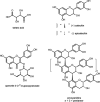Chardonnay Marc as a New Model for Upcycled Co-products in the Food Industry: Concentration of Diverse Natural Products Chemistry for Consumer Health and Sensory Benefits
- PMID: 36409321
- PMCID: PMC9732887
- DOI: 10.1021/acs.jafc.2c04519
Chardonnay Marc as a New Model for Upcycled Co-products in the Food Industry: Concentration of Diverse Natural Products Chemistry for Consumer Health and Sensory Benefits
Abstract
Research continues to provide compelling insights into potential health benefits associated with diets rich in plant-based natural products (PBNPs). Coupled with evidence from dietary intervention trials, dietary recommendations increasingly include higher intakes of PBNPs. In addition to health benefits, PBNPs can drive flavor and sensory perceptions in foods and beverages. Chardonnay marc (pomace) is a byproduct of winemaking obtained after fruit pressing that has not undergone fermentation. Recent research has revealed that PBNP diversity within Chardonnay marc has potential relevance to human health and desirable sensory attributes in food and beverage products. This review explores the potential of Chardonnay marc as a valuable new PBNP ingredient in the food system by combining health, sensory, and environmental sustainability benefits that serves as a model for development of future ingredients within a sustainable circular bioeconomy. This includes a discussion on the potential role of computational methods, including artificial intelligence (AI), in accelerating research and development required to discover and commercialize this new source of PBNPs.
Keywords: Chardonnay; byproducts; cardiometabolic health; computational modeling; flavanols; flavor; microbiota; oligosaccharides; phenolics; upcycle.
Conflict of interest statement
The authors declare the following competing financial interest(s): The following researchers have received research support from Sonomaceuticals, LLC: RRH and CLK (grant #A22-2323), DB (grant #A22-2313), SCW and XL (grant # A21-1888 and A22-2195), JPM Jr., and IT. FL and TA are employees of Sonomaceuticals LLC. HHS serves as a Sonomaceuticals LLC scientific advisor.
Figures




Similar articles
-
Sensory quality and regulatory aspects of upcycled foods: Challenges and opportunities.Food Res Int. 2025 Jan;199:115360. doi: 10.1016/j.foodres.2024.115360. Epub 2024 Nov 17. Food Res Int. 2025. PMID: 39658162 Review.
-
From waste to value: Integrating legume byproducts into sustainable industrialization.Compr Rev Food Sci Food Saf. 2025 May;24(3):e70174. doi: 10.1111/1541-4337.70174. Compr Rev Food Sci Food Saf. 2025. PMID: 40260833 Free PMC article. Review.
-
Approaches for reducing wastes in the agricultural sector. An analysis of Millennials' willingness to buy food with upcycled ingredients.Waste Manag. 2021 May 1;126:283-290. doi: 10.1016/j.wasman.2021.03.018. Epub 2021 Mar 27. Waste Manag. 2021. PMID: 33784572
-
Impact of Bottle Aging on the Composition and Sensory Properties of Flavored Chardonnay and Shiraz Wines.Foods. 2020 Sep 1;9(9):1208. doi: 10.3390/foods9091208. Foods. 2020. PMID: 32882844 Free PMC article.
-
Impact of sustainability and nutritional messaging on Italian consumers' purchase intent of cereal bars made with brewery spent grains.J Food Sci. 2021 Feb;86(2):531-539. doi: 10.1111/1750-3841.15601. Epub 2021 Jan 18. J Food Sci. 2021. PMID: 33462803
Cited by
-
Volatile Organic Compound-Based Predictive Modeling of Smoke Taint in Wine.J Agric Food Chem. 2024 Apr 10;72(14):8060-8071. doi: 10.1021/acs.jafc.3c07019. Epub 2024 Mar 27. J Agric Food Chem. 2024. PMID: 38533667 Free PMC article.
-
In vivo tracking of grape marc biomarkers, bioconversion, metabolic tracers, and microbiota modulation in swine fed a polyphenol-rich extract diet.PLoS One. 2025 Jun 10;20(6):e0325079. doi: 10.1371/journal.pone.0325079. eCollection 2025. PLoS One. 2025. PMID: 40493643 Free PMC article.
-
Mycelium: A Nutrient-Dense Food To Help Address World Hunger, Promote Health, and Support a Regenerative Food System.J Agric Food Chem. 2024 Feb 7;72(5):2697-2707. doi: 10.1021/acs.jafc.3c03307. Epub 2023 Dec 6. J Agric Food Chem. 2024. PMID: 38054424 Free PMC article. Review.
-
Upcycling flavanol-rich Chardonnay and Pinot noir grape thinned clusters as potentially functional food ingredients in cocoa-based products.Food Sci Nutr. 2023 Apr 4;11(6):3497-3505. doi: 10.1002/fsn3.3338. eCollection 2023 Jun. Food Sci Nutr. 2023. PMID: 37324846 Free PMC article.
References
-
- Sesso H. D.; Manson J. E.; Aragaki A. K.; Rist P. M.; Johnson L. G.; Friedenberg G.; Copeland T.; Clar A.; Mora S.; Moorthy M. V.; Sarkissian A.; Carrick W. R.; Anderson G. L.; et al. Effect of cocoa flavanol supplementation for prevention of cardiovascular disease events: The COSMOS randomized clinical trial. American Journal of Clinical Nutrition 2022, 115, 1490–1500. 10.1093/ajcn/nqac055. - DOI - PMC - PubMed
-
- Li J.; Wang J.; Yao Y.; Hua J.; Zhou Q.; Jiang Y.; Deng Y.; Yang Y.; Wang J.; Yuan H.; Dong C. Phytochemical comparison of different tea (Camellia sinensis) cultivars and its association with sensory quality of finished tea. LWT 2020, 117, 108595.10.1016/j.lwt.2019.108595. - DOI

